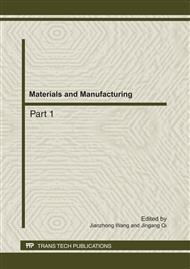p.408
p.412
p.417
p.422
p.427
p.432
p.436
p.440
p.444
Corrosion Behavior of Zr53.5Cu26.5Ni5Al12Ag3 Bulk Amorphous Alloy in 3.5% NaCl Solution
Abstract:
The corrosion behavior of Zr53.5Cu26.5Ni5Al12Ag3 bulk amorphous alloy in 3.5% NaCl solution was investigated by using potentiodynamic polarization experiments and electrochemical impedance spectroscopy (EIS). The results show that Zr53.5Cu26.5Ni5Al12Ag3 bulk amorphous alloy has the better corrosion resistance than its corresponding crystal alloy. During the bath in the 3.5% NaCl solution at 25°C, Zr53.5Cu26.5Ni5Al12Ag3 alloy has the lower corrosion current density than the corresponding crystal alloy. After 100h, the corrosion current densities of Zr53.5Cu26.5Ni5Al12Ag3 and the corresponding crystal alloy are 3.8415×10-8A/cm2 and 5.2827×10-7A/cm2, respectively. The results of EIS test indicate that Zr53.5Cu26.5Ni5Al12Ag3 bulk amorphous alloy has the excellent corrosion resistance because passive film with stable structure formed on the surface in 3.5% NaCl solution. With an increase in the immersion time, the passive film becomes thicker. It leads to impedance resistance and corrosion resistance decrease. The surface of Zr53.5Cu26.5Ni5Al12Ag3 bulk amorphous alloy in 3.5% NaCl solution for 100h was analyzed by SEM and EDS. The results show that the corrosive pitting can be found at both the amorphous alloy and the corresponding crystal alloy. However, the amorphous alloy has the better corrosive pitting resistance than the crystal one because the corrosion products formed by selective dissolving of Zr and Al elements. Moreover, the addition of Ag element helps to improve the corrosion resistance of the amorphous alloy greatly.
Info:
Periodical:
Pages:
427-431
Citation:
Online since:
July 2011
Authors:
Price:
Сopyright:
© 2011 Trans Tech Publications Ltd. All Rights Reserved
Share:
Citation:


